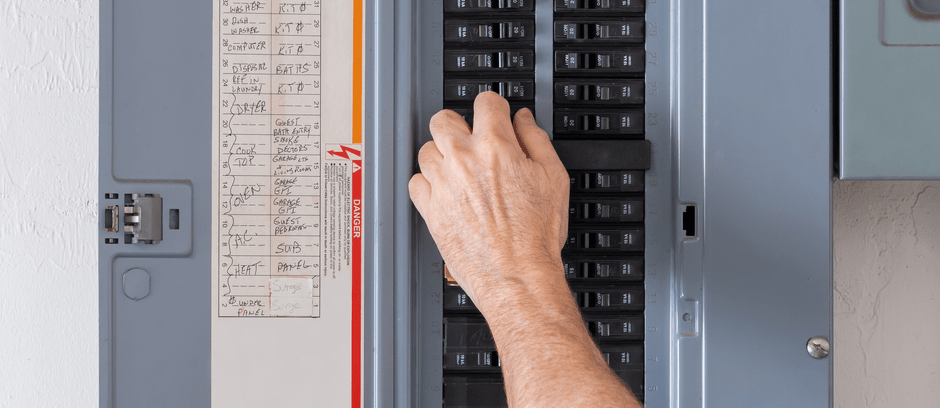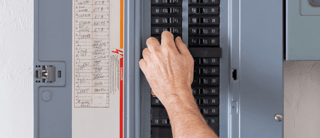How to fix a blown fuse
Fuse replacement techniques, including how to change a fuse in a fuse box

Key tips to remember
- When dealing with electricity, always use appropriate safety gear
- Spend a few bucks on a set of common fuses you might need
- Familiarize yourself with your home’s electrical panel and zones
- Remember, fuses are made to blow, and breakers are made to trip
- If at any time you feel unsafe, be sure to call in a professional
Got the blown fuse box blues? Don’t let a broken fuse get you down. Though it might feel like a big deal at the moment you lose power, one of the easiest DIY fixes a homeowner can learn is how to fix a blown fuse. It’s important to know your way around a fuse box; otherwise, a blown-fuse house call will only enrich your local repair technician for a few minutes’ work at the full price of an hourlong service visit. Still, safety trumps a repair bill every time, so by all means call for professional help if you aren’t comfortable working with fuses or electrical systems. What does a blown fuse look like so you know what to look for, and why do you need to know how to tell if a fuse is blown? We’ll tackle these questions and more in this post, so stick around for the lowdown on blown fuses and DIY techniques.
Safety first
Anytime you’re thinking of doing a little DIY tinkering that involves your home’s electrical system, erring on the side of caution should be your go-to approach. Just go ahead and unplug everything, including whatever you were using when the power went out, which is likely part of the problem, and cut power to the fuse or breaker box. Somewhere within the home, particularly if your circuit breaker keeps tripping or fuses keep blowing, it’s likely that you’ve overloaded a circuit. The last thing you want to do is leave everything plugged in and blow the same circuit yet again. Make sure you have rubber-insulated work gloves and eye protection, along with rubber-soled shoes and dry hands, just in case. This is obvious hopefully, but don’t try this if you have standing water in your home. Wait for the water to recede or call a professional for help. As we’ve mentioned, this is what you should do if you’re not comfortable at any point in this process. Your safety is the real priority here.
Replacement fuses
Speaking of safety, remember that fuses are designed to burn out, just as breakers are designed to break. Both are safety devices made to protect your home’s electrical system from overloading and causing fires or other damages, so don’t worry if you must deal with either one. It likely just means your home is functioning as intended, and maybe you should use a little less power on a circuit or two. Along with the safety equipment we mentioned, you’ll want to make sure you have a selection of commonly used replacement fuses in a range of amperages. Never attempt to replace a fuse with another one of a different amperage. Doing so could pose a dangerous fire hazard. You can buy an inexpensive set of fuses that includes a range of ratings at any hardware store, but always be sure to match both the amperage and voltage ratings when replacing a blown fuse. If you don’t want to buy a set, and since they’re expensive, you can remove the burned-out fuse and take it to the shop for a single replacement. But it’s nice to have a few extras at home just in case you need them.
Get to the panel
Go ahead and grab a headlamp or a handheld flashlight for when you get to the electrical panel. On the outside chance that you’ve never seen your electrical panel (your fuse box or breaker box), which houses the breaker switches or fuses that protect the various circuits feeding power to different rooms (or zones) in your home, now’s as good a time as any to familiarize yourself with where the panel is located and what it can do for you. Hopefully, it’s labeled inside so you can see which switches or fuses apply to which circuits. If not, you’ll want to label these so that next time is easier. In this case, you’re in for some experimentation to see what happens when you flip various switches. Fuse boxes are usually found in utility rooms or garages, but sometimes they’re in attics or basements, storage rooms or even closets. There’s usually a metal door on the outside of the box. If you can’t find the fuse box and still have your home inspection report, check the report for the description and location. It should be in there somewhere.
Blown-fuse confirmation
If your home’s electrical panel features a circuit breaker, you want to look for a switch that’s moved from the “on” to “off” position, or one that looks like it’s somewhere in between. Clicking this single switch back into the “on” position should restore power to the circuit that you accidentally overloaded. However, if your home has a fuse box instead, you’ll want to look at all the fuses to make sure none have melted and that none of their tiny glass windows are discolored. Another telltale sign of a blown fuse is when the wire in the window appears to have a gap. Spotting any of these signs is a safe bet that you’ve found a fuse that needs to be replaced. When you find one, remove it and replace it with an identical new one. Again, be careful to ensure that the amperage and voltage ratings match.
Blown-fuse removal and testing
Not all fuses are designed identically. Some are easily snapped into (and out of) place with fingers, while others are manipulated more easily with small pliers, tweezers or screwdrivers. Once you’ve successfully removed the blown fuse and replaced it with the identically rated new fuse, you’re ready to test the circuit. Turn the power back on. If the same fuse blows again, you could have a different problem. Try plugging in fewer appliances on the same circuit and replace the fuse once more. If the same fuse still blows, you might need professional help.
Repeat offenders
If the same fuse repeatedly blows out, and you remain determined to avoid calling for professional help, other causes could include bad connections at wall plugs, new appliances or devices that use more power than the circuit can handle, a problem within an appliance itself, an overloaded outlet, or even loose wires somewhere inside the wall. Most of these you can troubleshoot without breaking into the drywall. But if you’re uncomfortable at any point, it’s a good time to call a professional. In fact, some protection plans even cover problems like these so you can stay on the couch and not even bother with any of it.
Root causes
Again, most blown fuses or tripped breakers are caused by overloading a single circuit, like when you have too many appliances running in your kitchen simultaneously, or when your teenager has plugged in one too many devices in a gadget-filled bedroom. However, if the same fuse keeps blowing (or the same breaker keeps tripping), and you keep replacing it without getting to the root of the problem, you might do some damage to your appliances, your devices, and even to your electrical system itself. It’s possible you’ll need to upgrade a circuit that repeatedly overloads so that it can meet the electrical demand of your modern home. Some older homes can’t keep up with contemporary current demands and device loads and will need electrical upgrades accordingly.
Preventing another blown fuse
Everyone knows what Ben Franklin supposedly said about an ounce of prevention being worth a pound of cure, so why not take steps to prevent future fuse and breaker hassles? One thing you can do is make sure you know precisely which outlets in your home apply to which circuits; in other words, get to know your zones so that you can make better plans for your electrical power needs. If this means moving some devices and appliances around into different rooms with larger circuit capacities, so be it. The next time you decide to have a licensed electrician check out your home, ask about your home’s total capacity, how to find out what it is, and how knowing it can help you plan your electrical needs. You may also want to look into whether a home warranty covers electrical issues.
Parting thoughts
Make sure your electrical panel is easily accessible and not blocked by furniture or anything else. Remember, many cars and electronic devices like stereos contain fuses to support various electrical functions. Identifying them and replacing them are no different from the careful steps you’d take when replacing fuses in your home’s electrical system. The same advice applies. Good luck with your electrical troubleshooting! We’re glad you stopped by.
The information in this article is intended to provide guidance on the proper maintenance and care of systems and appliances in the home. Not all of the topics mentioned are covered by our home warranty or maintenance plans. Please review your home warranty contract carefully to understand your coverage.



